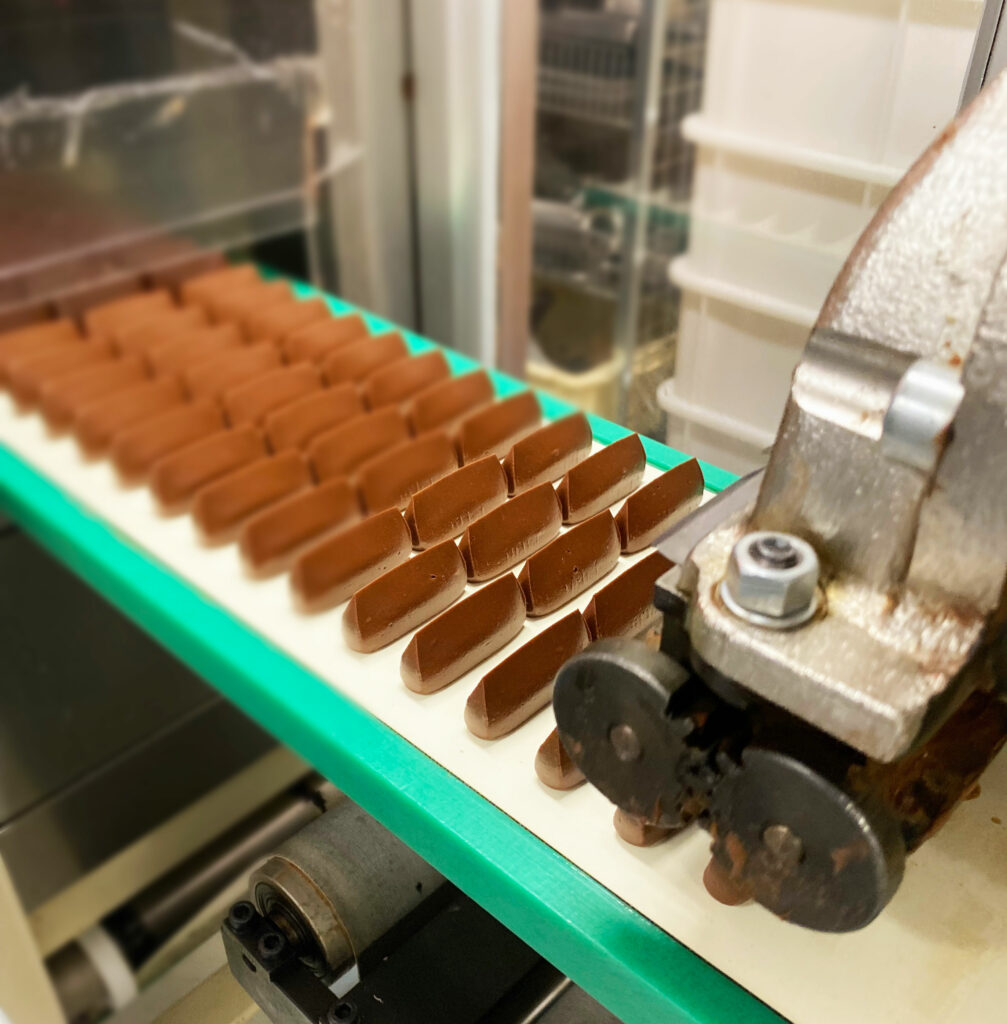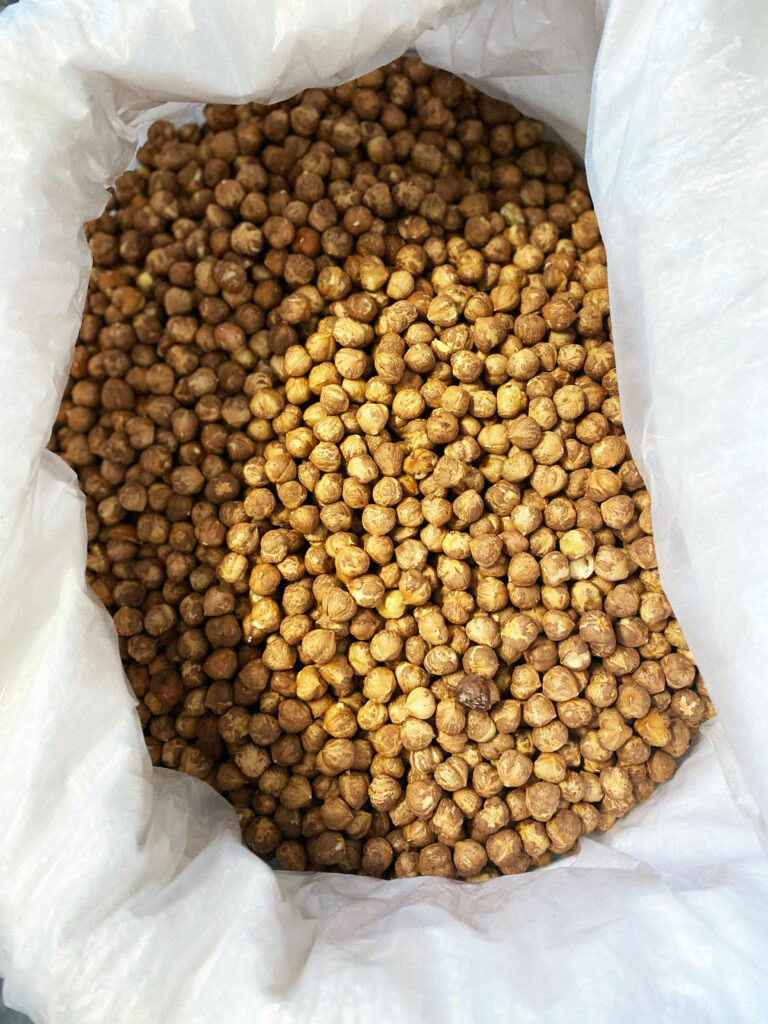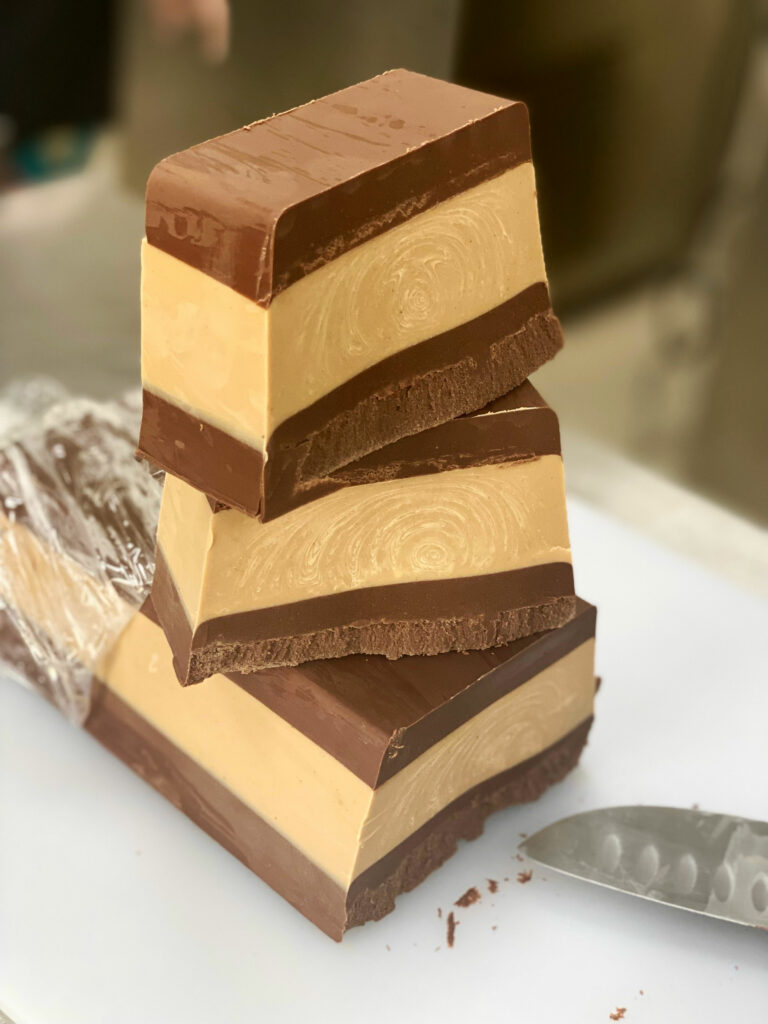The story of Gianduia is an interesting one, where necessity becomes the mother of invention. As the main story unfolds, the creation of Gianduia begins in 1806 when Napoleon issued the Berlin Decree, and blocked trading ships in war torn areas that included Italy. England retaliated in their own blockade, further limiting trade, and Italy was swept up in a war of sanctions, with no movement to the port of Genoa. As a result, there were many shortages of essential food items. Smuggling became rampant, and prices of cacao soared to sky rocketing prices. Although this has never been proven, it seems to be the accepted theory – that hazelnuts were then added to chocolate in order to make up for the fact that cacao was scarce. However, the lack of sugar, as well as no effective means to crush ingredients (other than by hand), gives rise to doubts of the accepted theories of the existence yet of a smooth, creamy paste which is the essence of Gianduia.
The word Gianduia as we know it today originates in a humorous character and puppet in Piemontese culture spelled as Gianduja, which represented Turin and the people of Piemonte. The product Gianduiotti refers to small solid chocolates which are individually wrapped and “boat shaped” like an inverted ship hull. In the late nineteenth century, these were also called “little chocolates of Gianduia” or “cioccolatini di Gianduia”.

Early recipes of Gianduia contained almonds, and even corn, which probably added some sweetness. Today, any Gianduia spread worth its glass jar will have a main content of hazelnuts from Piemonte, usually at least thirty percent. A producer who has such a substantial content of hazelnuts will commonly display it prominently on the front label. Tonda Gentile delle Langhe is the traditional hazelnut used to make a top Gianduia spread, hailing from the centre of Piemonte. They can be I.G.P. or Indicazione Geografica Protetta, and these small round beauties go beyond and above other hazelnuts with their complex flavours and aromas.

Until fairly recently Gianduia was not well known outside of Italy or even discovered by chocophiles. It may have something to do with Gianduia’s very regional character, and the fact that historically, confectionary production was very limited in Italy in the nineteenth century due to tariffs and trade unions. Although in the end this proved to be beneficial, as many enterprises were strictly family owned, where they sold authentic and specialized products in local markets. Gianduia became, and still is, a regional icon of Piemonte. Had it have been a more industrialized climate, surely the product genuineness and uniqueness that came from Italy’s grass roots would have been sacrificed.
La Guida Commerciale of Turin of 1842 lists Paul Cafferel with prominence as one of the first to mechanize production of Gianduia in Turin. He purchased a machine from a little-known Italian inventor, Bianchini, who used water and steam power to crush and smooth the paste that would become Gianduia. As the city of Turin improved the canals and water access in the city, this attracted more chocolate makers to the zone of Borgo San Donato which became the hub of Turin’s chocolate industry. Prochet Gay & Co, Moriondo & Gariglio and Talmone rose to prominence at this time where mechanization allowed for swift dominance of the market when most Torinese (of Turin) chocolate makers were still grinding chocolate by hand. Although Caffarel and Prochet are listed as the inventors of Gianduia, this is understood as unlikely, and there really is no known date of its invention.
Other advances occurred in this time period – Casparus Van Houten in Amsterdam invented a hydraulic press to extract cocoa butter from cacao nibs and created the first cocoa powder which was to become the basis for all chocolate products. And by 1904 Lindt’s conching technique from Switzerland made it easier to find Gianduia produced with finer and smoother particles. But it was only in the twentieth century that Gianduia would emerge as a milk chocolate product, as up until now it had mostly been produced and sold in a dark chocolate version.

No discussion on Gianduia would be complete without mentioning the multinational Ferrero Group and the impact they have had on Gianduia’s history. Their Nutella brand which evolved in the 50s and 60s was created for a mass market. This allowed for a wider distribution of a product that became a massive success for Italy’s economy, however with less recognition as an Italian product. Praised for its strength of brand, its investments, and industrial innovations of machinery, it propelled the president of the company to become one of the world’s richest billionaires as Nutella expanded internationally. In the last few years, the news and environmental impacts of some of Nutella’s ingredients has led to controversy for this Piemontese brand. However, the many lovers of Nutella stand true.
Today Gianduia is found all over Italy, in other parts of Europe, and also in North America in various reincarnations, inspired to return to its origins of genuine ingredients. The precise hours and strength required from modern machines now make the prized mixture of Piemonte IGP hazelnuts, cacao, sugar and real vanilla into the most creamy and velvety of concoctions. The extrusion of Gianduia into Gianduiotti with sophisticated machines attempt to mimic an elegant chocolate teardrop with a pastry bag artistry. Kudos to some Turin shops that hold out and still cut chocolate by hand! Older machines, although revitalized and repurposed, are seen as prized chocolate making machines from the past, and they are carefully guarded in some chocolate making labs. Let’s describe various points on how to purchase the best Gianduia which has become more widely available in an artisanal form:
- Hazelnuts will list as the first ingredient, not sugar.
- The hazelnuts should hail from Piemonte.
- Avoid extra fats – a quality spread has no need of extra fats other than those naturally present in the nuts and cocoa butter.
- Avoid artificial flavours like “vanillin”. This is not real vanilla.
- Both milk and dark chocolate Gianduia can be excellent.
- For an authentic Gianduia experience it’s best to choose some Gianduiotti or a Gianduia spread. Gianduia bars themselves will never be as rich and creamy as the former two items.
A few exceptional makers of Gianduia still exist in and around Turin. Our suggestion would be to spend a few days in this zone to discover some incredible chocolate adventures, and soak in the marvel of the Palazzo Reale as well as the many historic cafes, and elegant bars. And don’t even get us started on Cremini, that’s another layer of the story on Gianduia!



Add a comment